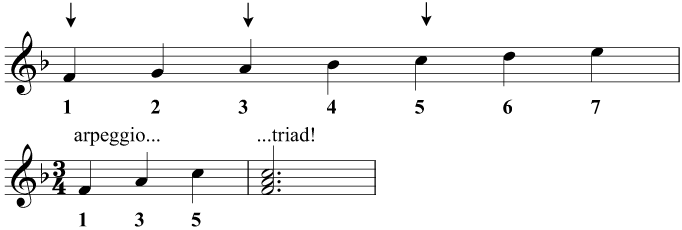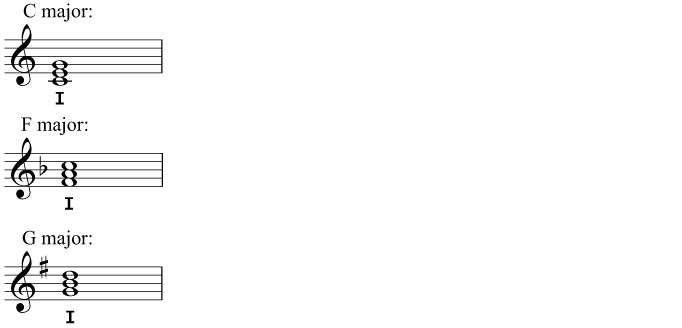Introduction to harmony
In this guide...
Key terms:
Subscription required!
To view the complete study guide, you will need a valid subscription. Why not subscribe now?
Already have a subscription? Make sure you login first!
Introduction
In this section we learn about writing music with several parts at the same time, and introduce the concept of harmony. This will draw on what you have learnt about intervals.
What is harmony?
The term harmony simply refers mainly to notes which sound together, at the same time. By contrast, melody refers to notes which sound alone (one after another), for example a tune.
If you think of music written down in which several notes sound at once, then harmony is the "vertical" part, while melody is the "horizontal" part, with one note after another.
Harmony can also be thought of "horizontally", such as within a melody. In this case you can think of the cumulative effect of the notes which follow each other - the first note continues as a memory in the listener's ear, almost as if it was sounding at the same time as the note which follows.
The arpeggio
Think of the scales and arpeggios you play on your instrument. The arpeggio is formed of the 1st, 3rd, and 5th notes of the scale, and perhaps repeated over one or more octaves. These notes are played one after the other, but as we will see, are fundamental to harmony.
The example below shows how arpeggios are created from the 1st, 3rd and 5th degrees of the scale:
 Creating an arpeggio from the major scale in C major
Creating an arpeggio from the major scale in C majorTriads
The main building block of harmony that we will refer to is the triad.
A triad is made up of three different notes (think of "trio" or "trinity"). The first, main note is called the root. The triad is built upon the root with the note a third above the root, and another note a fifth above the root.
These other notes are called the third and the fifth of the triad. So far, nice and simple!
As you have no doubt realised, we have just described the creation of an arpeggio: but this time, the notes sound together and not consecutively:
 Creating a triad from the major scale in C major
Creating a triad from the major scale in C majorThis triad that we have created from the scale and arpeggio of C major is called the triad of C major.
In F major
Here is a triad of F major, created in the same way:
 Creating a triad from the major scale in F major
Creating a triad from the major scale in F majorTriads or chords?
You may have heard the term chord. A chord is the general name given to any collection of notes sounding together, and a triad is therefore also a type of chord, being three specific notes sounding together.
While you can say "a triad is a chord", it is incorrect, however, to say that "a chord is a triad", because a chord can by a collection of any three notes, or indeed more than three notes!
So far we have referred to the triad of C major. This could also be called the chord of C major. But because a chord can be more than three notes, a "chord of C major" can repeat any of the notes in the triad, and have them in any position.
Here are some examples of C major chords to illustrate this point:
 A collection of C major chords
A collection of C major chordsNotice that all of these chords only contain the notes found in the triad of C major! However, some of the notes are contained twice in a chord. We say that these notes are doubled, for example: "the third has been doubled" (if the third, E, is included twice or more in a chord of C major).
Labelling triads
We can refer to triads by their root name. So, for instance, C major can refer to the triad on C using 1, 3, 5 of C major. But, as we know, it can also refer to the C major scale, or the key of C major. The C major triad or any C major chord is also frequently called just "C". But this could also refer to the note.
There is a better, clearer way of talking about triads. We name a triad in terms of a key by labelling it after the scale degree of the root note.
In C major, the C major triad is built on the note C which is the first degree of the scale, the tonic, and so it is called the "tonic" triad.
For an even briefer yet equally precise label, it is conventional to use Roman numerals to label triads. The tonic triad, therefore, is labelled: I
More formally, we call this triad of C major,
- The root position triad on the 1st degree of C major
or:
- A triad of
Iin C major
 A triad of
A triad of I in C major, F major, and G majorRead more...
With a subscription to Clements Theory you'll be able to read this and dozens of other study guides, along with thousands of practice questions and more! Why not subscribe now?
Revision
Are you sure you've understood everything in this study guide? Why not try the following practice questions, just to be sure!